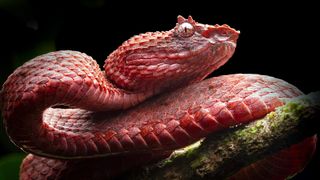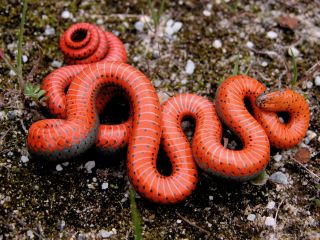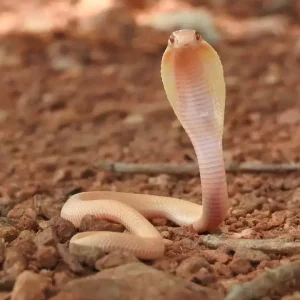
Snakes, like this eyelash pitviper, appear to evolve very quickly, allowing them to adapt and diversify and spread across the world. (Image credit: Alejandro Arteaga, Khamai Foundation)
Snakes have a supercharged evolutionary clock that enables them to adapt at far faster rates than other reptiles, scientists have discovered. This ability has helped them become evolutionary “winners” and spread across the planet.
“Snakes are like the Big Bang ‘singularity’ in cosmology — a dramatic expansion of diversity in species and their ecologies, linked to some event that might have occurred early in the evolutionary history of snakes,” lead author Pascal Title, a evolutionary macroecologist at Stony Brook University in New York, said in a statement.
In a new study, published Thursday (Feb. 22) in the journal Science, the researchers investigated what makes animal groups evolutionary winners — in particular, why certain groups are able to diversify into more species and appear better at surviving events like mass extinctions — study author Daniel Rabosky, an evolutionary biology at the University of Michigan, whose research focuses on macroevolution, told Live Science in an email.
New Snake Species Found in Another Snake’s Stomach
A snake pulled from inside another snake’s stomach was a species unknown to science — Cenaspis aenigma! Read the full story about the amazing discovery.
0 seconds of 1 minute, 26 secondsVolume 0%
The scientists looked at squamates, the order of reptiles that includes snakes and lizards and includes over 11,000 species. In this group, snakes, in particular, are widely diverse — the roughly 4,000 known snake species vary from venomous sea snakes, giant constrictors and hooded cobras to tiny threadsnakes that burrow to feed on ants and termites.
To find out why snakes are such an evolutionary success story, the researchers carried out a huge study of the genomes of almost 1,000 snakes and lizards. They also examined dietary preferences by looking at the stomach contents of over 60,000 museum specimens and field observations. With this data, they built up a comprehensive evolutionary tree of bodily and dietary changes in the group over time. They then used mathematical and statistical models to look at how snakes and lizards evolved.

Their findings suggest that snakes underwent several evolutionary explosions and evolved three times faster than lizards, in terms of diversity. After likely first emerging about 128 million years ago, there was a huge burst at some point between then and 70 million years ago, during the Cretaceous period (145 million to 66 million years ago), and another major pulse after the dinosaurs went extinct at the end of the Cretaceous.
This fast rate of evolution continues to this day, the team’s models show.
“Compared to lizards, they have changed relatively rapidly, and they’ve continued to do so through time,” Rabosky said. “So we would also say that the continued ‘evolutionary explosion’ of snakes is still ongoing today and appears partly driven by the fact that the rate of evolution — their ‘evolutionary clock’ so to speak — is just ticking a lot faster than many other groups of animals. This fast-ticking-evolutionary-clock is really important because it lets snakes evolve new traits quickly that can take advantage of opportunities that come up.”

Snakes’ evolutionary flexibility enables them to change their body shape and diets “very quickly,” he said. The initial “singularity” that led to snakes’ success appears to have started with them developing limbless bodies, flexible skulls and advanced chemical-detection systems.
These changes enabled them to target a huge array of prey, providing the framework for individual species to develop and specialize. Previous research published in 2021 shows the diversity in their diets exploded after the dinosaurs went extinct, with snakes quickly evolving new adaptations to take advantage of the new world they found themselves in — a dinosaur-less world in which mammals were starting to gain a foothold.
But why snakes ended up with a fast evolutionary clock in the first place is still a mystery. “This is the big question for us,” Rabosky said. “We can’t really explain this yet … But this is the nature of science, right? Usually, solving a mystery goes hand-in-hand with raising new questions that you have to answer.”
And snakes are likely continuing to adapt and evolve in super-quick time. “This is obviously speculation, but we don’t see any signs that the rapid evolution of snakes is slowing down,” Rabosky said. “Snakes seem to be continuing to evolve new ways of life, and I have every expectation that this would continue into the future.”





